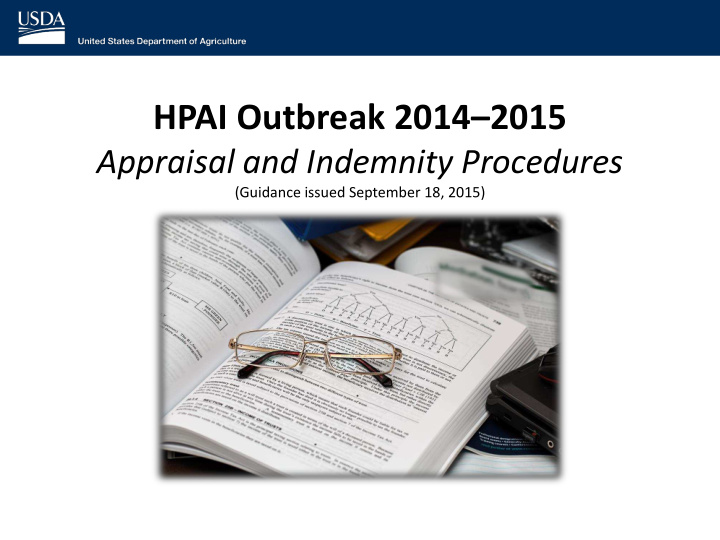



HPAI Outbreak 2014 – 2015 Appraisal and Indemnity Procedures (Guidance issued September 18, 2015) 1
Policy Update Provides responders with revised procedures learned from the 2014 – 2015 highly pathogenic avian influenza (HPAI) outbreak. Key Components General Requirements Procedures Special Note for First Detections of HPAI in a State Information Required for Appraisal and Indemnity 2 2
General Requirements Best practices to contain/eradicate HPAI by stamping-out within 24 hours require: – rapid depopulation, – appraisal, – and indemnity procedures. Depopulation of any birds or eggs must be approved by State Animal Health Officials (SAHOs) and APHIS, which will require rapid communication between: – producer, – company, – State officials, – APHIS, – and laboratory officials. These appraisal and indemnity procedures apply to both the first detection of HPAI in a State and subsequent HPAI detections in a State. 3
Procedures 1. Inventory of poultry and other required information should be compiled as soon as: a) FAD investigation is initiated or, b) an HPAI presumptive positive case is identified or, c) an HPAI suspect case is identified or, d) whichever is earliest. 2. A State or APHIS official will help the owner, grower, licensed veterinarian, or company official to submit information electronically to HPAI OPS Group, SAHOs, VS District, and/or IMT. a) APHIS officials will collect hard copies of all documents (e.g., barn records) used to substantiate indemnity claim. 3. VS 1-23 Appraisal & Indemnity Claim Form is created by APHIS based on information provided including the age, sex, type and value of the birds. Indemnity values for birds and eggs are provided by the HPAI OPS group based on current USDA calculators. 4. If Veterinary Services (VS) District or Incident Management Team (IMT) cannot meet the 24 hour deadline to prepare VS 1-23 – HPAI OPS Group will prepare. 4 4
Procedures (continued) 5. As soon as the HPAI presumptive positive case definition is met, or joint State-APHIS decision to depopulate is made, a State or APHIS official will obtain a signature on the completed VS 1- 23. Signatures will be electronically submitted prior to depopulation; hard copies for all records and the VS 1-23 will be collected by APHIS officials. 6. In some investigations, the HPAI suspect case definition will be used to initiate depopulation; the same above procedures will apply. 7. A signed flock plan (owner, APHIS, State animal health official) will no longer be required for indemnity payments, but is required for State quarantine or hold order release, APHIS disposal assistance, and APHIS cleaning and 5 5 disinfection assistance.
Special Note for First Detections of HPAI in a State Please send samples to the National Animal Health Laboratory Network (NAHLN) and National Veterinary Services Laboratory (NVSL) at first indication of increased mortality or clinical signs, and follow FAD investigation procedures to maximize speed of APHIS international trade notifications. Don’t wait to rule out other causes. Duplicate or second set of samples are the standard for FAD investigations. NVSL confirmation is not required for depopulation and indemnity, but is required for APHIS international trade notifications. Timely reporting prevents unnecessary trade disruptions with some trading partners. 6 6
Information Required for Appraisal and Indemnity M ust be sent to the preparer of the VS 1-23 and some information may need to be provided or verified by the owner, grower, private veterinarian, VS, or SAHO. Type of flock (turkey, chicken, County of premises layer, breeder, backyard, etc.) Premises Identification Number Flock information including the (PIN) — location of infected poultry, age, sex, breed, and number of not company home each type of bird; number of birds The GPS coordinates and 911 in each barn; barn mortality address of premises records Name of facility/complex Date of onset of clinical signs (if Claimant name and address present) Confirmation of mortgage status Date of facility quarantine Appraisal Date – date value is Reason for test (area surveillance, assigned to birds/eggs pre-movement, NPIP (National Name of NAHLN lab submitting Poultry Improvement Plan), sick- samples bird call) 7 7
USDA HPAI Incident Coordination Group (ICG) Contact Information The below personnel are part of the USDA OPS Group (and larger ICG), which may include rotating personnel. The HPAI OPS Group is to be notified of all HPAI FAD priority 1, 2, or A HPAI investigations, HPAI suspect cases, and HPAI presumptive positive cases. No need to email the HPAI OPS Group personnel individually if the HPAI OPS Group main is working. However, phone contact and conference calls are required for and FAD investigations. USDA OPS Group: hpaiops@aphis.usda.gov To: Patricia.E.Fox@aphis.usda.gov; Jonathan.T.Zack@aphis.usda.gov; Fidelis.N.Hegngi@aphis.usda.gov; LeeAnn.Thomas@aphis.usda.gov Cc: Thomas.J.Myers@aphis.usda.gov; Burke.L.Healey@aphis.usda.gov; Elizabeth.M.Brown@aphis.usda.gov; Sharon.S.Fisher@aphis.usda.gov 8 11
For More Information APHIS FAD PReP Website VS Guidance Document 12001: Policy for the Investigation of Potential Foreign Animal Disease/Emerging Disease Incidents (FAD/EDI) Ready Reference Guide: Procedures and Policy for FAD Investigations (VS Guidance Document 12001) FAD Investigation Manual (FAD PReP Manual 4-0) 9 11
Recommend
More recommend